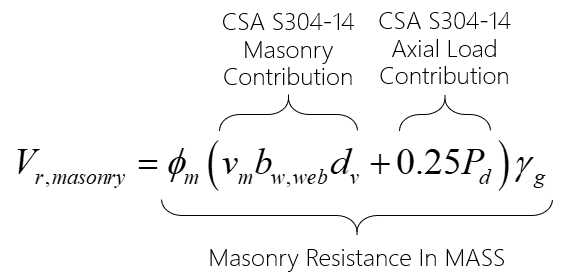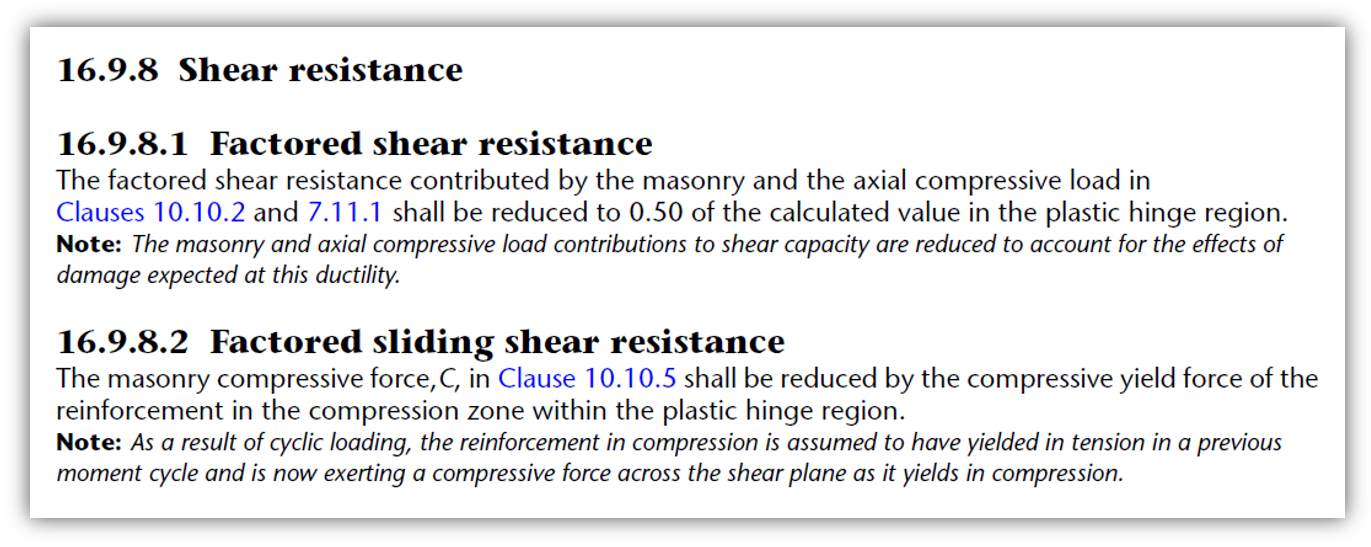
Latest Software Blog Posts
Why is masonry shear resistance reduced for seismic effects in a shear wall design?

When Shear Resistance is Reduced, Have No Fear!
Seeing the masonry component of a shear wall’s shear resistance is a part of everyday life in these uncertain times. There are three scenarios where any increased expected damage resulting from higher ductility will reduce the degree to which the masonry can be relied upon to resist the in-plane shear experienced within the plastic hinge.

These cases are outlined in the subsections below.
Disclaimer: This post is exclusively intended to provide insight into the approach taken by the MASS design software in interpreting a CSA S304-14 code compliant seismic design. It is up to the professional discretion of the designer to input an appropriate layout, boundary and loading conditions, interpret the results, and determine how they should be incorporated into their designs. As per the end user license agreement (and also recommended within PEO’s guidelines for using engineering software), a tool cannot be considered competent and reliance on a tool does not relieve the user of responsibility.
Terminology
While the clauses outlined in the rest of this post refer to separate contributions from the masonry and axial load where the reduction is applied to each, MASS internally includes the axial load with the cross sectional properties in calculating what is output as the “masonry component of a shear wall’s shear resistance:

A new term, Vr,seismic is then calculated by taking a percentage of Vr,masonry, as applicable. The formulas in the detailed output reference Vr,initial which represents the masonry contribution of shear resistance before any seismic effects are considered.
Moderately Ductile Shear Walls
For designs where the ductility SFRS force modification factor is equal to 2.0, the masonry component of the total factored shear resistance must be reduced in accordance with CSA S304-14: 16.8.9:

For designs in this SFRS category, Vr,seismic is calculated by multiplying Vr,masonry by 0.75 – a 25% reduction from the initial value.
Note: Since these shear resistance reductions are only applied to the plastic hinge region, there is similar clause in this category for squat shear walls, as they do not have a plastic hinge.
Ductile Shear Walls
For designs where the ductility SFRS force modification factor is equal to 3.0, the masonry component of the total factored shear resistance must be reduced in accordance with CSA S304-14: 16.9.8.1:

For designs in this SFRS category, Vr,seismic is calculated by multiplying Vr,masonry by 0.50 – a 50% reduction.
There is also a provision from Clause 16.9.8.2 which states that reinforcement in compression can no longer be included in the masonry compression force, C, used in the in-plane sliding shear resistance equation found in CSA S304-14: 10.10.5.1:

The reduction from Clause 16.9.8.2 refers to the bars in compression that would have been included in determining C that can no longer be considered from Clause 10.10.5.1. This is taken into account within MASS when applicable for each seismic load case.
Higher Compressive Strains
For shear wall designs that make use of boundary elements to achieve higher compressive strains, the masonry contribution to in-plane shear resistance is reduced in accordance with CSA S304-14: 16.10.4.1:

This reduction is a function of the increase in maximum compressive strain from the initial seismic value of 0.0025.
The same sliding shear reduction in C that was seen for ductile shear walls also exists here, for cases where increased strains are present in designs that are moderately ductile.
Concluding thoughts
For designs taking advantage of higher levels of ductility, there are considerations that will affect the shear deisgn process. MASS applies these resistance reductions as required which are seen in the simplified shear results. If any of the results are unclear or you have any further questions, please do not hesitate to contact MASS support for assistance.
Additional Reading: Why is the Factored Shear Force Scaled up on a Shear Wall Design?
Was this post helpful?


